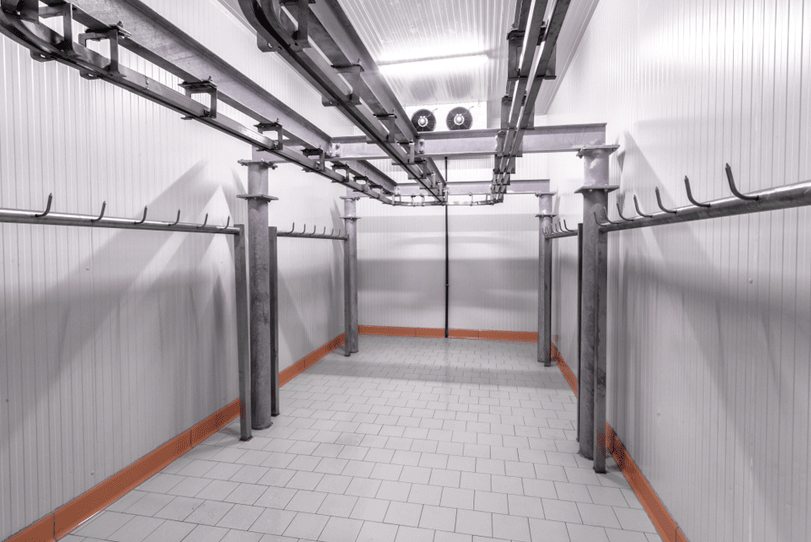Industry leaders craft a comprehensive discussion on the trending investment and opportunities to bloom the cold chain infrastructure, and challenges faced by the cold chain industry in terms of transportation.
The demand for cold chain logistics services in India is primarily driven by bulk agricultural commodities (predominantly potato storage), consumer segments such as frozen food, dairy, confectionery, high-value fruits and vegetables, and pharmaceuticals segments.
There has always been a shortage of cold chain capacity, but sustained interest and increase in demand from new sectors such as Fruits and Vegetables, Meat, Seafood and bio-pharmaceuticals, which are pre-dominantly exported oriented, has resulted in an addition of about 4.5-5 million tonnes of cold-chain capacity in India. Stringent US FDA norms have added an obligation for critical temperature monitoring, and hence the preference largely stays for organised players. There has been an increased focus by the government of India on developing farm to fork cold chain infrastructure as seen in the recently announced SAMPADA scheme. Setting up pack-houses is thus being seen as an emerging business opportunity with multi product cold stores within 50-100 kms from the farm gates as collections centres and increased investment in refrigerated vehicles for Pan India distribution.
Current market trends
The industry is growing day by day, and lots of commodities are moving through cold chain across the states. Consumers are flocking to fresh foods. Fresh fruits, food and perishable commodities that were transported through traditional trucks are now moving through cold chain, at a flexible and ambient temperature, further broadening their shelf-life as well as keep the nutrient value intact.
Divyansh Rathore, Business Head-Temperature Controlled Logistics, Future Supply Chain Solutions Ltd., mentions few key points including focus on maintaining temperature integrity of products across the value chain, investments in technology, temperature controlled supply chain, quality compliance, sustainable activities and initiatives by industry.“The industry is estimated at `25,000 Cr in 2017, the cold chain industry is expected to grow at a rate of 13-15 per cent in the next 5 years thus taking the industry to `50,000 Cr by 2022. 3 key segments namely exports of meat, sea food and bio-pharma products are expected to buoy growth in the cold chain industry”, he adds.
According to Rahul Agarwal, Director, Kool-ex Integrated Cold Chain Solutions, “The current infrastructure is fragmented and there is also a need for creating larger warehouses to enable economies of scale. The next five years will see consolidation and emergence of larger capacity storage and transportation facilities”.
However, the demand for Cold Chain Logistics in India has been intensifying off-lately in both both in the Warehousing & Trucking segments. This is being driven both by Food and Perishable’s sector as well as the Pharmaceutical Sector. There is also a move by strategic players to acquire Cold Chain Assets.
Eason Cheng, Marketing Manager – Refrigeration, APAC, CAREL says that the Indian cold chain logistics market is estimated by recent marketing research to be in continuous and rapid growth for the next few years, and in this scenario, it’s easy to imagine how critical both quality goods preservation during transformation and transport processes and total energy consumption in refrigeration will be.“Remote management is also an important trend in India. With a boom in cold chain construction, however managing these cold chain infrastructures with limited skilled technicians may be a big problem in the near future. Remote management, such as remote alarms, data logs, system analysis and centralised monitoring systems with machine learning and system diagnostics will be the answer”, he adds.
“Over these few years, we have noticed a shift in focus towards an end to end cold chain from just storage. Technology advancements have also been adopted to offer technology driven solutions specific to Cold Chain, with inclusion of better and more sophisticated machinery and equipment”, says Aditya Vazirani, CEO, Robinson Cold Chain Logistics.
Higher demand and expectations of consumers for frozen and ready to eat food with the quality and hygienic products compel the intensive use of refrigerated rooms and transport means throughout the food supply chain, which improved the life cycle of the product and maintain the nutrition value and freshness of the product. According to Bhupender Singh, MD, Ravi integrated Logistics “New tools and technologies keep now the differentiation is the technology in maintaining the product at the right specifications like temperature, packing, handling, humidity etc., throughout the supply chain”.
Defying the storage challenges
The development of cold chain warehouses in India has been skewed towards single product storage of potatoes since it also contributes to about 20 percent of agricultural revenue in this country. Most of the facilities are located in Uttar Pradesh, Gujarat, West Bengal, and Punjab thus created a lack of storage options in the rest of the country. The lack of development of multi-commodity cold chain facilities can be attributed to multiple factors such as high real estate prices, lack of clarity on changes in land use pattern and dependence on imported technology for refrigeration.
“The need of the hour is to increase the investments in cold chain infrastructure and to ensure uniform distribution of these assets across the country. There have been numerous state and central level subsidy schemes that provide up-to 35 percent support on the capital expenditure or support at the interest rates thus making ROCE of the investment more viable”, says Rathore. Such subsidies help in funding the viability gap which is a major concern for most investors. An estimated investment of more than USD 150 million has been put into cold chain companies by PE firms which are expected to improve the farm level infrastructure through the development of pack houses, ripening chambers and other allied transportation services. Focus of the industry will thus shift from single commodity storages to modern multi commodity facilities with the scope of consolidation and introduction of better technology thus optimising the entire supply chain
Where as Agarwal doesn’t find single commodity storage a big concern. “There is a growing demand for Quality Warehousing in the Pharma Sector. This sector is very quality and compliance conscious and would not like to store its medicines with other products”, he adds. Moreover, stringent regulatory norms will further add constraint on having quality storage.
Talking about the storage concerns, Singh says, “Single commodity cold storage consumes more spaces then the multi-commodity cold storage. Cold storage cost will directly dependent on that product pricing.” He further adds that the cold storage used for single commodity doesn’t really fit into the quality requirement, hence are not equipped to handle the products mechanised. The products are handed in traditional ways and manually and are integrated with using old technologies and gases which are harmful to environment. Cold storage facilities are dealing with these challenges by moving in-to a multi-commodity cold storage facility. Interestingly, Mr. Kool is comes with first State of the art fully mechanised cold warehouse at Dadri, Ghaziabad having multi-user, multi-commodity and multi-temperature facilities.
On discussing the same, Vazirani highlights that around 30 percent of agricultural produce is wasted due to lack of available infrastructure in the supply chain. Apart from agriculture, other perishable food, including dairy, poultry, and processed food that require temperature control, go astray following inefficient cold chain. In such a scenario, cold storage warehouses designed to only accommodate single commodity storage, remains to be a challenge, as it hinders the optimisation of already scarce resources. Additionally, these set ups are also a huge burden on the energy and financial resources, which could have been optimised to generate better ROI.
Technological encumbrance in preserving fragile goods
Since shelf life of perishable products is less, it is important to have good quality asset for long haul distribution, maintaining accurate temperature and humidity throughout transit. Agarwal here highlights that cost being the cost of distribution; it becomes a challenge for perishable products which are low in value. Also, since the movement over longer distances is time consuming, the shelf life of the product can be impacted due to delays in transit. Another challenge is the maintaining of temperature in transit. It is crucial to continuously monitor the temperature in real time, as a small excursion can spoil/ damage the product.
Maintaining stable storage conditions both in terms of temperature and humidity is the key in these solutions. Making the total refrigeration system run smoothly to minimise the impact to stored products requires different levels of system control. Electronic expansion valves, variable speed compressors and fans can maintain the evaporating temperature very stable, in some case, with a variation of just +-0.1, therefore reducing the temperature and humidity impact on the products. This surely helps provide longer storage times and maintain the products in better condition. Adding to the description, Cheng says, “Normally however, it means an increase in capital investments, and this will be the biggest challenge for these solutions. We at Carel, believe that energy saving to reduce operating costs and minimise product waste can help users understand how applying advanced technology is a wise investment in terms of both cost and food quality. We have developed a specific algorithm for the cold room controller to avoid skipping defrosts. High/low voltage protection can also help ensure system reliability.”
Vazrani feel that staff training remains a major challenge. Although domestic freight transport is also one of the key challenges, but it is highly restricted.While railways used frequently, they are not as robust as required, waterways for domestic transport are yet to be developed, and air freight is highly expensive. Hence the most common and affordable mode of transport remains the roadways, which translates into higher time and thus higher risks for damage or inefficient temperature control for perishable goods.
Temperature controlled services, especially transportation, have the dual challenge of being time bound and temperature sensitive. Rathore mentions that ensuring their retention is one of the key challenges this industry faces. Skewed demand for temperature controlled vehicles in the long haul sector (loads concentrated in west and north) also results in reduced utilisation of vehicles since reverse haul movement becomes a challenge.
Most of the food products have a very short life span, and hence require intense temperature management to preserve their shelf life, so transporters’ key challenge is, return load. According to Singh, in India, road transportation is a primary and critical concern, following non-reliable condition of roads and traffic in different areas which increases the time of delivery and painful challenge for the transporters. Also limited time of entry to cities for transport vehicles makes the distribution cost more costly and delay in distributions.
Growth prospects for cold chain in F&B industry
Currently most cold storages in India are smaller in size ranging from 5-12000 Pallets. We feel that multi-commodity storage facilities with minimum size of 25000 Pallets will be ideal for the future needs and there is tremendous scope to build huge facilities which can cater to domestic as well as exim trading of commodities. If the storage facility supports the logistics, both inbound and outbound, the service provider can move up the value chain and offer bundled services to the user, thereby ensuring stickiness of customer.
Noting the same, Rathore highlights “We are predominantly focused on the Pharmaceutical sector. However, for the Food & Beverage industry the opportunity lies in building large scale cold storages which will reduce the cost per pallet and a better understanding of product seasonality’s, thereby enabling better utilisation of space.” Consumer awareness towards quality and shelf like is also enforcing companies to use better storage and transportation conditions thereby leading to upgradation towards quality infrastructure.
Whereas according to Singh “Although the current business is passing through the difficult time in the current market scenario but demand is growing day by day but there is still scope of growth, which even can be observed from our growth. Mr. Kool had started operations with 8 vehicles in March’15 and now we are having 250+ company owned reefer vehicle and our Newly build State of the Art Cold-Storage with 6,000 MT capacity at Ghaziabad location, while another 30,000 MT is in pipeline for the next financial year.”
Final note
The F&B sector is expected to grow given the increase in purchasing power of consumers and the fact that consumers have become more conscious of ingredients and labeling as a result of recent scandals in this industry. Given the time bound nature of replenishment to F&B touch points and importance of maintaining quality at each link of the cold chain, focus of the industry will shift from single commodity storages to modern multi commodity facilities with multi-temperature distribution options. This will lead to a consolidation and introduction of better technology thus optimising the entire supply chain. With global sourcing, comes the challenge of managing a multi-country, multi-modal supply chains. There is hence a growing demand for alternate solutions such as thermal covers / blankets, eutectic plates and non-fossil fuel based technologies that can sustain temperature under extreme conditions for longer durations of time.
Investments in cold chain infrastructure and uniform distribution of their assets across the country is a prerequisite.
Divyansh Rathore, Business Head-Temperature Controlled Logistics, Future Supply Chain Solutions Ltd.
Although cold chain construction is widening its base in India, but scarcity of skilled technicians management seems unyielding in future.
Eason Cheng, Marketing Manager – Refrigeration, APAC, CAREL
This sector is very quality and compliance conscious and would not like to store its medicines with other products, and regulations can add more quality constrains for product preservation.
Rahul Agarwal, Director,Kool-ex Integrated Cold Chain Solutions
Technology advancements, with inclusion of better and more sophisticated machinery and equipment are driving the Indian cold chain industry.
Aditya Vazirani, CEO, Robinson Cold Chain Logistics
New tools and technologies add authencity the technology in maintaining the product at the right specifications throughout the supply chain.
Bhupender Singh, MD, Ravi Integrated Logistics
Cookie Consent
We use cookies to personalize your experience. By continuing to visit this website you agree to our Terms & Conditions, Privacy Policy and Cookie Policy.















